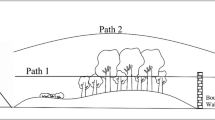Abstract
The time history of the sound pressure level (SPL) of a passing high-speed train is asymmetric. In this paper, the noise generated by a high-speed train was investigated, and the influence factors of the time history of the SPL were analyzed. The difference in the sound travel time from each part of the train to the receiver was the primary reason for the asymmetry. An improved calculation method was proposed by introducing a propagation time correction. The calculated curve derived from the optimized method was consistent with the measured data acquired from the China Beijing–Shanghai Railway.



Similar content being viewed by others
References
Golebiewski, R.: The noise directivity of railbuses. Appl. Acoust. 72, 653–659 (2011)
Makarewicz, R., Yoshida, M.: Railroad noise in an open space. Appl. Acoust. 49, 291–306 (1996)
Salomons, E.M., Zhou, H., Lohman, W.J.A.: Efficient numerical modeling of traffic noise. J. Acoust. Soc. Am. 127, 796–803 (2010)
van Leeuwen, H.J.A.: Railway noise prediction models: a comparison. J. Sound Vib. 231, 975–987 (2000)
Zhang, X.T.: The directivity of railway noise at different speeds. J. Sound Vib. 329, 5273–5288 (2010)
Moehler, U., Kurze, U.J., Liepert, M., Onnich, H.: The new German prediction model for railway noise “Schall 03 2006”: an alternative method for the harmonised calculation method proposed in the EU directive on environmental noise. Acta Acust. United Acust. 94, 548–552 (2008)
Moehler, U., Liepert, M., Kurze, U.J., Onnich, H.: The new German prediction model for railway noise “Schall 03 2006”—potentials of the new calculation method for noise mitigation of planned rail traffic. Noise Vib. Mitig. Rail Transp. Syst. 99, 186–192 (2008)
Ringheim, M.: The new Nordic prediction method for railway noise. J. Sound Vib. 193, 277–282 (1996)
Thron, T., Hecht, M.: The sonRAIL emission model for railway noise in Switzerland. Acta Acust. United Acust. 96, 873–883 (2010)
Thompson, D.: Railway Noise and Vibration. Elsevier, Oxford (2009)
Morse, P.M., Ingard, U.: Theoretical Acoustic. McGraw-Hill, New York (1968)
Acknowledgments
The author is grateful to Yan Shuang for the help she provided during the study.
Author information
Authors and Affiliations
Corresponding author
Rights and permissions
About this article
Cite this article
Wu, D., Ge, J. The Asymmetry of the Time History of the High-Speed Train Pass-By Noise. Acoust Aust 43, 169–173 (2015). https://doi.org/10.1007/s40857-015-0022-7
Received:
Accepted:
Published:
Issue Date:
DOI: https://doi.org/10.1007/s40857-015-0022-7




